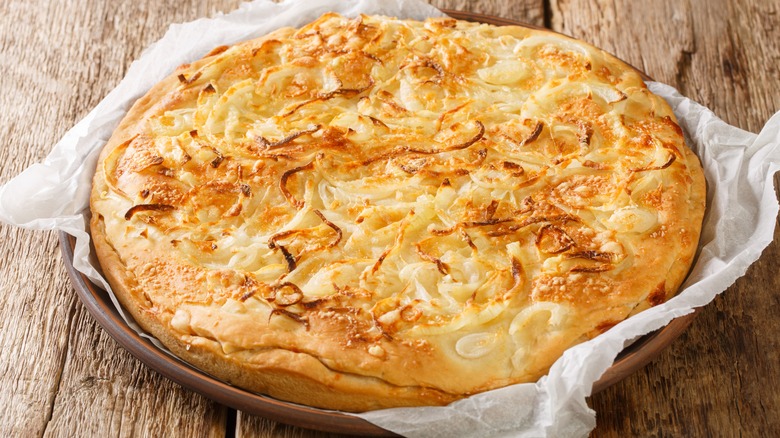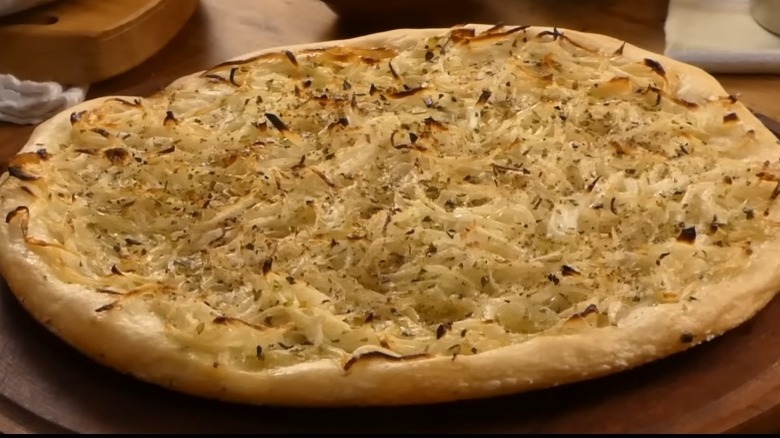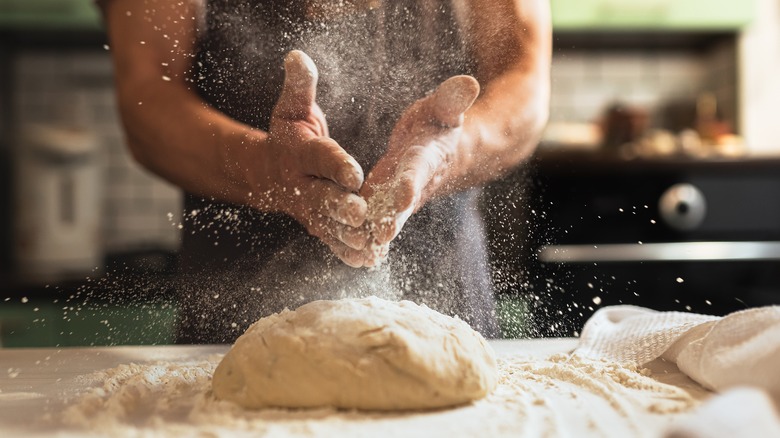The South America Pizza That Comes Smothered In Sweet Onions
Pizza may have been invented by Neapolitans during the 18th century, as History notes. But in the centuries since, people around the globe have discovered interesting ways to put their own spin on the classic Italian dish. Tarte flambée, for example, is a French variation pioneered in the country's Alsace region. According to Matador Network, it's one of several pizza variations originating in European countries other than Italy. There's also the sandwich-style Zapiekanka pizza from Poland, Norway's enormous Grandiosa frozen pizzas featuring Jarlsberg cheese, and the flatbread Spanish pizzas known as coca.
Pizza variations have proliferated in the Americas, too. And, no, we're not just talking about New York-style thin-crust pies or Chicago's distinctive deep-dish pizzas. South American countries have also contributed to global pizza culture, per Taste Atlas, from Peru's stir-fry style lomo saltado pies to the fugazza and fugazzeta variations for which Argentina is famous. Both Argentinean pies are generously layered with onions, it should be noted, but fugazzeta is stuffed, whereas the sweet onion-laden fugazza is made more in the Italian tradition. That should not be surprising, observes The Argentine Kitchen, given that fugazza was invented by a man of Italian heritage.
The origin of Argentina's fugazza pizza
Juan Banchero's father may have come from Genoa, Italy, per Banchero Miami, but the culinary creation for which Juan is remembered was invented in Buenos Aires, Argentina, notes The Argentine Kitchen. Banchero originally referred to his tomato-less pie as fugazza con queso. Today, however, the pizza is known simply as fugazza, a name derived from fugassa, the Genoese word for focaccia.
Banchero's father, Don Agustín Banchero, established a bakery called Riachuelo in Buenos Aires after immigrating to the city in 1893 (per Banchero Miami). It was at this bakery that Juan first created his fugazza con queso. The exact date of the pizza's birth is not known, per Banchero Miami, but Juan's showcase for it — the now iconic Pizzería Banchero — officially opened on March 28, 1932. That same decade saw the founding of several other historic pizzerias in Buenos Aires, including Güerrin, Las Cuartertas, and El Cuartito, observes La Nación.
More than 90 years after its opening, Pizzería Banchero's original location is still serving up fugazza in Buenos Aires' La Boca neighborhood. Several other Banchero pizzerias have followed, including one in Miami Beach, Florida (pictured), per Banchero Miami.
The ingredients of fugazza pizza
Pizzería Banchero's Miami Beach location serves fugazza with only three toppings: Onions, provolone, and olives. However, many other ingredients can be added to the iconic pie, depending on one's preferences. Cheddar, mozzarella, and Parmigiano-Reggiano cheeses, for example, can all be added to the fugazza in its "con queso" form, observes The Argentine Kitchen. Parmesan is also an option, although as The Spruce Eats notes, the focaccia-style fugazza is often best when served meatless and cheeseless, topped only with oregano and onions, the latter given their sweetness by a sautéeing in olive oil.
Nowadays, cheese lovers are more likely to opt for the fugazzeta, an evolutionary variant of the original fugazza stuffed with mozzarella but also enjoys a liberal topping of onions, per Taste Atlas. A sub-variant of fugazzeta called fugazetta de verdura not only includes sautéed onions but also sautéed spinach and other vegetables. Another sub-variant, fugazzeta con jamón, is made with ham.
How fugazza is made
According to The Argentine Kitchen, fugazza's pizza dough ingredients should include flour, yeast, salt, sugar, and water, with olive oil optional. Unlike many other pizza doughs, the one for fugazza doesn't need to be rolled or stretched, notes The Spruce Eats. Instead, it can simply be fitted to a baking pan.
Fugazza's signature topping, onions, should first be sautéed with olive oil in a skillet for approximately 10 minutes until they acquire a golden brown color, confirms The Spruce Eats. Onions, oregano, salt, and optional ingredients like cheese or olives can then be placed on the dough as toppings before the pizza is baked in the oven.
For fugazetta, the dough is divided into two portions, which are fitted in the baking pan around an interior stuffing of mozzarella or other cheeses. The Argentine Kitchen recommends covering the two-layer dough with a topping of onions before baking.



